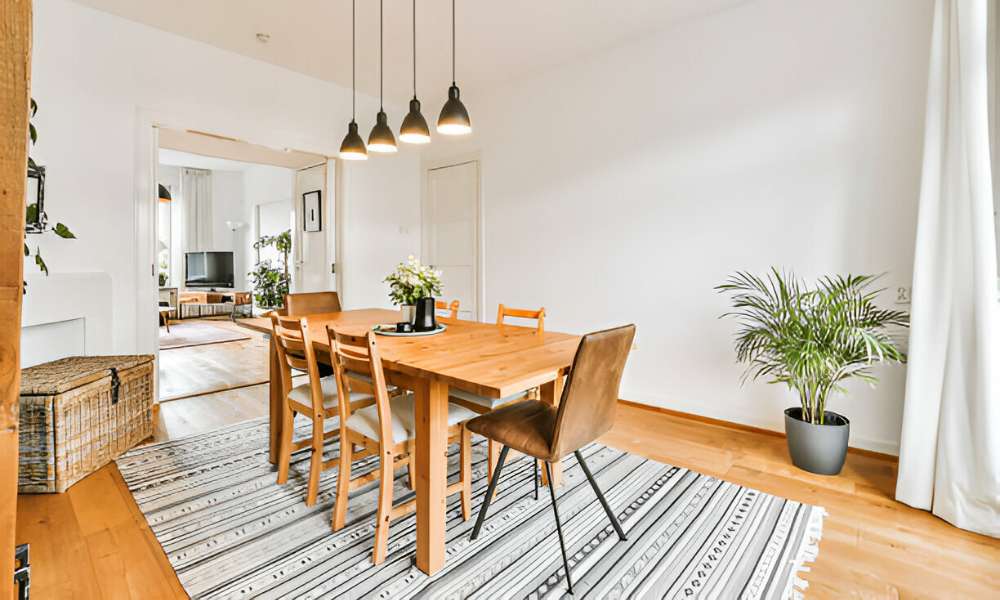Selecting the right size rug for your dining table is not just a practical detail—it’s a crucial design choice that can significantly influence the aesthetics and functionality of your dining space. A well-chosen rug helps define the dining area, adds comfort underfoot, and can serve as a stunning visual anchor that complements your table and chairs. However, with so many sizes, shapes, and styles available, choosing the perfect rug can seem daunting. In this article, we will guide you through the process of determining the ideal rug size for your dining table, taking into consideration the dimensions of your furniture and room, as well as stylistic elements to ensure a harmonious look. Whether you have a cozy round table or a grand rectangular one, finding the right rug size will enhance your dining experience and elevate your home décor.
1. A Rug Under The Dining Table Is A Necessity
Placing a rug under the dining table is not merely a decorative choice—it’s a functional necessity that enhances the dining experience. A well-chosen rug helps define the dining space within larger rooms or open-plan areas, creating a cozy, inviting atmosphere. Beyond aesthetics, rugs under dining tables also provide practical benefits such as noise reduction from chairs moving and dishes clattering, which can be particularly valuable in homes with hard flooring. Furthermore, a mat adds a layer of comfort underfoot, making the dining area more welcoming for extended meals and gatherings. By choosing the right mat, you not only elevate the style of your dining space but also improve its usability and comfort, making it a pivotal element of your home decor.
2. Understanding the Basics of Dining Table Rugs
An area rug is a piece of fabric or material that covers a specific portion of the floor, typically used for decorative purposes, sound insulation, and comfort. A dining table is the central furniture piece in this room where meals are served, around which chairs are arranged for seating. Clearance refers to the amount of space left around the dining table on the mat, ensuring chairs can be moved in and out without catching on the rug’s edge.
The general rule for placing rugs under dining tables is to ensure the mat is large enough to accommodate all chairs comfortably, even when they are pulled out from the table. Typically, a mat should extend at least 24 inches beyond the table on all sides. This guideline helps prevent chairs from catching on the edge of the mat and ensures that the dining set fits neatly within the rug’s boundaries, contributing to a tidy and cohesive appearance. Understanding these basics will help you make informed decisions as you select the ideal rug for your dining space.
3. Factors to Consider Before Choosing a Rug Size
Choosing the right rug size for your dining area involves considering several factors to ensure a harmonious and functional space. Firstly, the shape and size of this table play a critical role; a round table might pair best with a round mat, while a rectangular table typically looks good with a rectangular mat that mirrors its proportions. Secondly, the dimensions of your room dictate the maximum rug size that can comfortably fit without overwhelming the space. It’s essential to leave a border of flooring around the mat to frame it nicely within the room.
Additionally, the layout of surrounding furniture should influence your rug choice. Ensure that the mat allows for a natural traffic flow and doesn’t obstruct the opening of doors or pathways. Lastly, aesthetic and design considerations such as style, color, and pattern are crucial. The mat should complement the room’s overall decor, either by coordinating with existing colors and styles or by serving as a bold statement piece that adds contrast and interest. Balancing these factors will help you select a mat that looks great and enhances your dining space’s functionality.
4. Standard Rug Sizes Under Different Shapes
When selecting a rug for your dining table, the shape of the table should guide your choice of rug size to ensure a well-proportioned and appealing setup.
For rectangular tables, a rug that extends at least 24 inches beyond the table on all sides works best, allowing ample room for chairs to be moved in and out without snagging on the edge. Standard mat sizes for these tables often range from 8’ x 10’ to 9’ x 12’, depending on the table size and room layout.
For round tables, choose a round rug that complements the table’s diameter while providing enough surface area for all chairs. A general rule is to select a rug that extends at least 30 inches beyond the edges of the table. This could mean a mat diameter that’s at least 6 feet for smaller tables.
Square tables pair nicely with square rugs, echoing the shape and maintaining balance in the design. Like with rectangular tables, ensure the mat extends beyond the table by at least 24 inches.
Oval tables often work well with either rectangular or oval rugs. The key is to mirror the table’s longest dimensions with the mat’s size, ensuring it extends beyond the table similarly to round and square setups.
These guidelines help in creating a cohesive dining area where the mat enhances both the table’s functionality and aesthetic appeal, ensuring all chairs remain comfortably on the mat, even when occupied.
5. How to Measure for the Perfect Rug Size
Measuring for the perfect rug size under your dining table requires a methodical approach to ensure both aesthetic harmony and functional use. Start by measuring the dimensions of this table, then add at least 48 inches to both the length and the width. This addition accounts for the space needed to comfortably pull out and push in chairs without the risk of them catching on the mat’s edge. For instance, if your table measures 60 inches long by 36 inches wide, your mat should ideally be at least 108 inches long and 84 inches wide.
Additionally, consider the room’s overall balance when selecting your rug. Ensure there’s enough floor space around the mat to avoid a cramped appearance and to allow for smooth traffic flow around the dining area. It’s also wise to mark out the mat’s dimensions on your floor using painter’s tape to visualize how it will fit within the existing space. This step can help you avoid common measuring errors and ensure that the mat enhances both the functionality and style of this room.
6. Common Mistakes to Avoid
When selecting a rug for your dining area, there are several common pitfalls to avoid to ensure optimal functionality and aesthetic appeal. One frequent mistake is choosing a rug that’s too small. This not only disrupts the visual balance of the room but also causes practical issues, such as chairs catching on the edge of the mat when moved. Another critical aspect often overlooked is the mat’s material and maintenance needs. Dining areas typically experience frequent spills and stains, so opting for a mat material that is durable and easy to clean—like polypropylene or a treated natural fiber—is crucial.
Additionally, many people overlook the importance of rug padding. Padding not only prevents the mat from slipping but also adds a layer of cushioning, which enhances comfort and prolongs the life of the mat by reducing wear. Ignoring these factors can lead to dissatisfaction with the mat’s performance and appearance, necessitating premature replacements or adjustments.
7. Additional Tips and Tricks
When incorporating a rug into this room, aligning it with the existing decor is key. Choose a rug that either complements or thoughtfully contrasts with your room’s color scheme and style. For instance, a vibrant, patterned mat can add a splash of color to a neutral space, while a subtle, monochrome mat can tone down a brightly decorated room. Regarding durability and cleaning, opt for rugs made from materials that can withstand frequent foot traffic and spills. Synthetic fibers, wool, or treated cotton are excellent choices because they offer ease of maintenance and longevity.
For unconventional dining spaces, such as small apartments or rooms with an irregular shape, consider custom-sized rugs or use multiple smaller rugs creatively arranged to define the space effectively and enhance its unique layout. These additional tips and tricks can help you maximize the practicality and aesthetic potential of your dining area mat, making it both a beautiful and pragmatic addition to your home.
What If My Dining Area Is An Open Plan?
In open-plan dining areas, a rug can help define the dining space, creating a visual separation from the rest of the room. Choose a rug that complements the scale of the dining table and the surrounding living areas. Opt for colors and patterns that harmonize with the overall decor, maintaining a cohesive look across the open space. It’s also important to ensure the mat is proportional to the dining set while still distinguishing the dining area as a dedicated space within the larger room.
How Do I Handle High-Traffic Dining Areas?
For high-traffic dining areas, durability and ease of cleaning are paramount. Materials such as polypropylene, nylon, or indoor-outdoor rugs are ideal as they can withstand significant wear and are easy to clean. Consider darker colors or patterned rugs that can hide stains and dirt effectively. Regular maintenance, including vacuuming and prompt stain removal, will also help preserve the mat’s appearance and longevity.
Can I Use Multiple Smaller Rugs Instead Of One Large Rug?
Using multiple smaller rugs instead of a single large rug is a creative solution for adding texture and color to your dining area. This approach can be particularly effective in eclectic or bohemian-style interiors. When choosing multiple rugs, ensure they share a common design element, like color or pattern, to maintain a unified look. Arrange the rugs so that each dining chair stays completely on one mat to avoid imbalance when seated. This setup can also be practical for replacing individual pieces in the future if they wear out or you wish to update the decor.
Conclusion
Choosing the correct size rug for your dining table is crucial for both functional and aesthetic reasons. It not only enhances the overall look of your dining area but also ensures practicality by accommodating all chair movements comfortably. The key takeaway is to ensure the rug extends at least 24 inches beyond the table on all sides, allowing for ease of movement and maintaining the balance of the space. When selected thoughtfully, considering the room’s dimensions, the table’s shape, and the surrounding decor, a well-placed rug can transform a simple dining area into a stylish and welcoming gathering space. Remember to factor in the material and maintenance needs of the mat to ensure it remains a lasting and valuable part of your home decor. With these guidelines, you’re well-equipped to select the perfect rug that complements this table and enhances your living space effectively.





